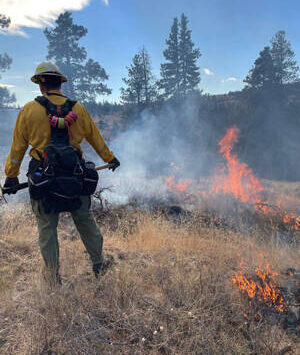Scores, state mandates and evaluation methods dominate school board discussion
TONASKET – A presentation by Tonasket School District administrators explaining the latest method of evaluating school proficiency turned into a lengthy discussion about the district’s scores and the constantly shifting landscape that districts have to cope with in evaluating their effectiveness.
The three school principals, at the Monday, Oct. 29, Tonasket School Board meeting, explained how the Annual Yearly Progress (AYP) standard that had been used to determine how well schools were doing their jobs has been thrown out in favor of Annual Measurable Objectives (AMO).
“They AYP is gone,” said Superintendent Paul Turner. “The Feds gave us a waiver — it could come back, we don’t really know — we no longer compare with neighboring districts. We only compare with ourselves. We look at our previous score and have to hit a percentage of growth from there.”
The scores will be based upon an “achievement gap” as measured in 2011, which is the difference between where the students perform, and 100 percent. For example, if a school scored at 80 percent efficiency, half that gap (10 percent) would need to be closed by 2017, or two percent per year.
Most Tonasket scores did not meet AYP goals, so while the principals acknowledged they still have a lot of work to do, they were encouraged by the incremental approach the AMO allowed.
“I think the AMO is a great challenge,” said middle school principal Jay Tyus. “It gives us a fair, reachable measure, so now we need to go and get it. The first thing that we did with the AYP was go and look to see how other schools were doing.
“I has created some urgency. Now we have to face the reality that our data has been ‘flat’ for a few years. So now, we have to beat ourselves.”
He pointed out that, statistically speaking, it only would take a few students improving their scores for the district to reach the mandated goals.
“If our end result (goal) is 75 percent, that’s the minimum,” Tyus said. “That’s not what we shoot for.”
The biggest area of concern with the scores, in terms of demographics, came with the low income and English-as-a-second-language students. Tyus said one of the steps being taken was to visit higher-scoring, like-sized districts that had similar demographics to see if they could identify what they were doing that improved their effectiveness.
All three principals and special education director Liz Stucker made similar presentations, which sparked some questions from the board.
“I can really appreciate that you woke up one day and everything that had looked fine was no longer fine,” said board member Catherine Stangland. “But these growth goals in my opinion are miniscule and not acceptable, quite honestly.
“It’s not OK if only 56-58% of our kids are growing. It’s not OK if our goal is 75%. That still leaves 25 percent of the kids not growing. That’s just not what we want. … We’ve been aligning curriculums for 20 years, at least 15, and now we’re going to do it again. We’ve been deconstructing standards, doing interventions, righting the pyramids. But there is something we’re missing… Is it because we keep changing the way we keep measuring ourselves or what we’re calling this or that? We’ve all laid out plans, honestly none of them sound new.”
High school principal Jeff Hardesty said that the “shifting sands” of state legislation was one reason why the district has held steady with NWEA (Northwest Evaluation Assocation), which provides data on each individual student’s growth.
“If you study state standards, they essentially change it every other year,” Hardesty said. “So for example the math scores at the high school, we outscored the standard by six percent. But when the legislature changes the law again and requires all kids to pass both and the ninth graders may or may not be able to bank the scores, you’ll see another dip. The last time we presented our NWEA scores, we showed improvement. But as a parent, yeah, I’m concerned about the percentages.”
“One of the concerns I have throughout all three schools in the presentation we have a number of how many kids have to test right to meet our goals,” said board member Ty Olson. Two, three whatever… I’m really concerned that subconsciously we could become complacent with finding that number and say we’re fine because we met our goals.”
“We’re reacting to a change in the legislature,” Hardesty said. “The complacency may fall on their shoulders, not ours. They put this incremental growth in and it’s empowering because it’s not so overwhelming. But knowing these people and myself, complacency is not in our vocabulary.”
“If someone could tell me, ‘If you do this, this will happen,’ I’d do it,” Stucker said. “Nobody can really say that to us. That’s why it’s important to see these other districts with similar demographics have been doing … What are they doing that their scores are better?
“Complacency is not in my vocabulary. I get irritated when I see stuff like this because it’s not OK.”
Olson compared the administrators’ situation with his business.
“There’s a lot of things in business we don’t change for four, five, six years at a time,” Olson said. “I feel like as a board, you guys got blindsided. You guys go one direction, they pass something, you go another direction, and then I have to believe something else will get passed for you. And then we’ll be going back over here.”
“Two years ago we were being asked about knee-jerking to the next best thing,” Hardesty said. “And to use data. Which is in part, Cathy, why you haven’t heard anything new. What the high school has found — and what everyone else has found — is that the RTI model (part of NWEA) transcends everything. It doesn’t matter if your skin is brown, red or purple. It is a systematic way to sort kids and address their needs… It’s staying the course on a model we believe in.”
Stangland said that part of the problem is that the board is only seeing numbers, and not necessarily what is going on with the students themselves.
“It’s helpful when you give us examples of students that are making big progress,” she said. “Because we see these numbers. We don’t see the kids that are making the big progress. The numbers are discouraging. So if you could do what you can to widen our vision it would be helpful.”
The board, citing a scheduling conflict, also rescheduled its Nov. 12 meeting. The board will now meet on Monday, Nov. 5, at 7:00 p.m.
For the actual state report card scores, see the OSPI Report Card website.




